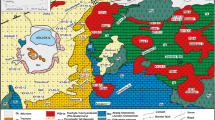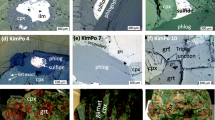Summary
A rare variety of Fe-Al-rich xenolith, tridymite-hercynite rock, was entrained in the Cenozoic basalt from Niutoushan, southeastern China. The tridymite-hercynite rock consists of hercynite (40–50%), tridymite (35–45%), ilmenite (≈2%), and glass (10–20%). Mineral grains are smaller than 0.05 mm with a granular texture. Compared to “normal” igneous rocks, this tridymite-hercynite rock has higher FeO, Al2O3, and lower SiO2 CaO, MgO, and alkalis (Na2O + K2O).
The origin of this type of xenolith is problematical. Based upon the available mineralogical and chemical data, three possible origins have been evaluated:
-
(1)
The product of an extreme tholeiitic fractionation under low oxidation conditions; but the major element geochemistry appears to negate this model.
-
(2)
The Fe-rich (Si-poor portion of silicate-immiscible liquids from an extremely fractionated residual tholeiite magma; however, the corresponding Si-rich end-member fraction is missing, and the composition of the tridymite-hercynite rock is different from that of any Si-poor melt phase of known immiscible silicate liquids.
-
(3)
The product of metamorphism, including partial to complete melting, of a sedimentary protolith. An Fe-Al-rich shale (quartz 5%, kaolinite 75%, hematite 20%) has the approximate composition of the tridymitehercynite rock. The trace-element abundances of the xenoliths suggest that the source rock for the Fe-Al-rich sedimentary protolith was an undifferentiated volcanic rock at the active continental margin.
Zusammenfassung
Fe-Al-reiche Tridymit-Hercynit-Gesteine kommen als seltene Einschlüsse in känozoi-schen Basalten aus Niutoushan, Südost-China vor. Das Tridymit-Hercynit-Gestein besteht aus Hercynit, (40–50%), Tridymit (35–45%), Ilmenit (2%) und Glas (10–20%). Korndurchmesser sind kleiner als 0.05 mm; die Textur ist granular. Verglichen mit “normalen” magmatischen Gesteinen hat dieses Tridymit-Hercynit-Gestein höhere FeO, Al2O3 und niedrigere SiO2, CaO, MgO und Alkali (Na2O + K2O) Gehalte.
Die Herkunft dieser Xenolithe ist problematisch. Auf der Basis der verfügbaren mineralogischen und chemischen Daten sind folgende Möglichkeiten überprüft worden:
-
1.
Als Produkt extremer tholeiitischer Fraktionierung unter niedrigen Oxydationsbedingungen; die Hauptelement-Geochemie spricht jedoch gegen dieses Modell.
-
2.
Als Fe-reicher (Si-armer) Anteil von Silikat-unmischbaren Schmelzen aus einem extrem fraktionierten tholeiitischen Restmagma; die entsprechende Si-reiche Endglied-Fraktion fehlt jedoch, und die Zusammensetzung des Tridymit-Hercynit-Gesteines ist verschieden von der Si-armer Schmelzphasen bekannter unmischbarer Silikatschmelzen.
-
3.
Als Produkt der Metamorphose mit teilweiser bis kompletter Aufschmelzung, eines sedimentären Protolithen. Ein Fe-Al-reicher Schiefer (Quarz 5%, Kaolinit 75%, Hämatit 20%) hat die ungefähre Zusammensetzung des Tridymit-Hercynit-Gesteins. Die Spurenelement-Gehalte des Xenolithen weisen darauf hin, daß das Ursprungsgestein des Fe-Al-reichen sedimentären Protolithen ein nicht differenziertes vulkanisches Gestein an einem activen kontinentalen Rand war.
Similar content being viewed by others
References
Ellison AJG, Hess PC (1989) Solution properties of rare earth elements in silicate melts: inférences from immiscible liquids. Geochim Cosmochim Acta 53: 1965–1974
Haskin LA, Haskin MA, Frey FA, Wildman TR (1968) Relative and absolute terrestrial abundances of the rare earth. In:Ahrens LH (ed) Origin and distribution of the elements. Pergamon, New York, pp 889–912
Hughes SS, Delano JW, Schmitt RA (1989) Petrogenetic modeling of 74220 high-Ti orange volcanic glass and the Apollo 11 and 17 high-Ti mare basalts. 19th Lunar and Planetary Science Conference, pp 175–188 (Proceedings)
Jezek DA, Sinton JM, Jarosewich E, Obermeyer CR (1978) Fusion of rock mineral powders for electron microprobe analysis. Smithsonian Contrib Earth Sci 22: 46–52
Kirkpatric RJ (1981) Kinetics of crystallization of igneous rocks. Rev Mineral 8: 321–398
Kouchi A, Sunagawa l (1983) Mixing basaltic and dacitic magmas by forced convection. Nature 304: 527–528
Longhi J, Pan V (1988) A reconnaissance study of phase boundaries in low-alkali basaltic liquids. J Petrol 29: 111–148
Longhi J, Pan V (1989) The parent magma of the SNC meteorites. 19th Lunar and Planetary Science Conference, pp 451–464 (Proceedings)
McLennan SM (1989) Rare earth elements in sedimentary rocks: influence of provenance and sedimentary processes. Rev Mineral 21: 169–200
Naslund HR (1976) An investigation of liquid immiscibility in the System K2O-CaO-FeO-Fe2O3-Al2O3-SiO2. Carnegie Institution of Washington Year book 75: 407–410
Neal C, Taylor L (1989) The nature of Barium partitioning between immiscible melts: a comparison of experimental and natural systems with reference to lunar granite petrogenesis. 19th Lunar and Planetary Conference, pp 209–218 (Proceedings)
Philpotts AR (1979) Silicate immiscibility in tholeiitic basalts. J Petrol 20: 99–118
Roedder E (1978) Silicate liquid immiscibility in magma and in the system K2O-FeO-Al2O3-SiO2: an example of serendipity. Geochim Cosmochim Acta 42: 1597–1617
Schairer JF, Yagi Kenzo (1952) The system FeO-Al2O3-SiO2. Am J Sei (Bowen volume) part 2: 71–512
Taylor SR, McLennan SM (1985) The continental crust: its composition and evolution. Blackwell, Oxford, p 312
Watson EB (1976) Two-liquid partition coefficients: experimental data and geochemical implication. Contrib Mineral Petrol 56: 119–134
Xie X, Yan M, Wang C, Li L, Shen H (1989) Geochemical reference samples: GSD9-12, GSSI-8, GSR1-6. Geostandards Newsletter 13: 83–179
Yu X (1985) The origin of basaltic rocks in Niutoushan area-high pressure differentiation. Geochemistry 4: 150–158
Zhou X (1981) An investigation of two basaltic series and their inclusions in Niutoushan of Fujian Province of southeastern China. Nanjing Univ Bull 81: 382–392 (in Chinese with English abstract)
Author information
Authors and Affiliations
Additional information
With 7 Figures
Rights and permissions
About this article
Cite this article
Qi, Q., Taylor, L.A. & Zhou, X. Petrology and geochemistry of an unusual tridymite-hercynite xenolith in tholeiite from southeastern China. Mineralogy and Petrology 50, 195–207 (1994). https://doi.org/10.1007/BF01164605
Received:
Accepted:
Issue Date:
DOI: https://doi.org/10.1007/BF01164605




